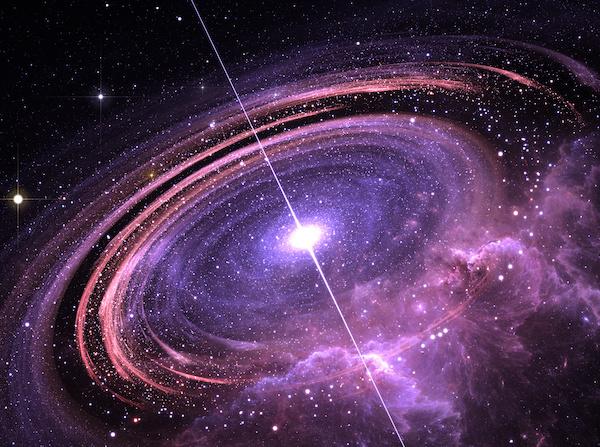
Neutron stars are one class of astrophysical object that both radiate heat and display magnetic reconnection, a phenomenon where magnetic field lines tear and realign. How these processes affect each other hasn’t been well-researched, but new experiments have shown it’s possible to study these conditions in a lab.
Peter Jurik
A new paper shows it’s possible to recreate extreme astrophysical events in a lab, opening doors to research on ubiquitous-yet-mysterious celestial processes.
July 31, 2024
Rishabh Datta, a fifth-year PhD student at MIT’s Plasma Science and Fusion Center, is shining a light on some dark corners of the universe. His new paper, “Plasmoid formation and strong radiative cooling in a driven magnetic reconnection experiment”, was an Editors’ Suggestion in Physical Review Letters, an honor only given to around 15% letters.
Datta studies magnetic reconnection, a phenomenon that produces all sorts of highly energetic astrophysical displays, like the Aurora Borealis and solar flares. Stars like our sun are burning balls of plasma, and that’s where magnetic reconnection happens—within the magnetic fields carried by plasmas. The “reconnection” part of magnetic reconnection describes what was once thought to be impossible according to the laws of our universe: there are circumstances where magnetic field lines can break apart, and then snap back together; when they do so, a significant amount of energy is released. A better understanding of magnetic reconnection can help us decipher the behaviors of plasmas writ large, which has implications for astronomy, physics, and ultimately harnessing plasma to generate fusion power.
Datta was interested in better understanding magnetic reconnection in a very common though little-studied environment characterized by a type of heat loss called radiative cooling. It’s a phenomenon seen many places, including when hot plasmas in astronomical bodies emit thermal energy and become colder.
According to Datta, “Magnetic reconnection and radiative cooling are two of the most ubiquitous processes in our universe.”
Neutron stars, for example, are stars that have run out of fuel, collapsed, and gone dark, though “dark” doesn’t equal “cold”; they are incredibly hot and experience intense radiative cooling, with extremely strong magnetic fields that violently reconnect and emit lots of X-ray energy in the process. “So how does radiative emission affect magnetic reconnection, and vice versa?” Datta wondered. “It remains an open question.”
To find answers, Datta collaborated with experts from several leading plasma physics programs, among them Princeton Plasma Physics Laboratory, Imperial College London, and Sandia National Labs, the latter of which is home to the Z machine, a warehouse-sized pulsed power source in Albuquerque, New Mexico, and the key to Datta’s experiment. MIT Professor Jack Hare, Datta’s PhD advisor, named the experiment MARZ, short for Magnetic Reconnection on Z. “Using the MARZ platform, we could directly measure how these two fundamental processes—radiative cooling and magnetic reconnection— affect each other.”
The Z machine accomplishes a lot during its nanoseconds of operation: it generates powerful magnetic fields and crams the equivalent of 800 lightning bolts (or 20 mega amperes) into an area the size of a few pencil erasers. Crucially, the Z machine can recreate the very strong radiative cooling effect that was at the heart of Datta’s research, making it possible to document the interplay between cooling and connection.
After more than a year of planning that included running simulations to optimize MARZ’s experimental design, Datta and his collaborators used the Z machine three times over the course of several months, recording each shot’s energy emissions with X-ray cameras, a first for this kind of experiment. Datta explained that they were able to “[…] measure how X-rays from the reconnection layer vary in time and space, which is important for better understanding astrophysical systems, especially because radiative emission is the key, and sometimes only signature of reconnection in objects like neutron stars.”
X-ray cameras positioned at different angles around the experimental array were able to capture a level of detail that previously hadn’t been possible, allowing Datta to document how the reconnection layer evolved, and if radiative cooling was present in the course the experiment’s miniscule 500 nanosecond duration.
After processing the outputs, Datta found that “X-ray images of the reconnection layer showed small areas of intense emission that moved very rapidly along the layer, which is consistent with plasmoid formation.” Plasmoids are an important part of reconnection because as magnetic field lines tear into thin sheets, plasmoids bubble up and move through the plasma.
“To break it down further, instead of uniform emission throughout the entire layer, what we saw were hotspots—the plasmoids— that emitted more energetic X-rays and were brighter than everything around them,” he explained. Datta was also able to capture the sharp decrease in those X-ray emissions about 220 nanoseconds into the experiment, which was a telltale sign that radiative cooling was occurring. “In an astrophysical context, when we observe high energy emission, it could be related to the generation of plasmoids during reconnection.”
In addition to building our understanding of the physics behind magnetic reconnection, Datta’s results show that you don’t need to go to space to study these phenomena; all you need is the world’s most powerful radiation source. “Working on the Z machine has been a highlight of my PhD career,” said Datta. “It is remarkable that we can produce plasma conditions found nowhere else on earth and learn more about the behavior of extreme astrophysical objects, right in the lab.”
Topics: Accelerators & detectors, High-energy-density physics, Lab astrophysics (LDX), Plasma theory & simulation, Jack Hare, Chikang Li